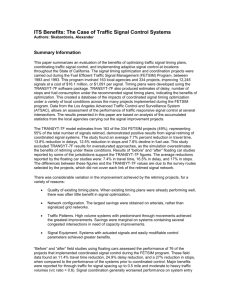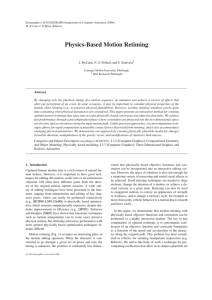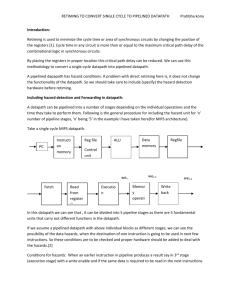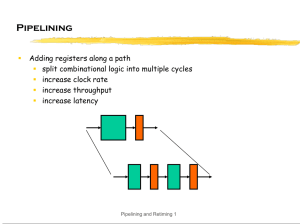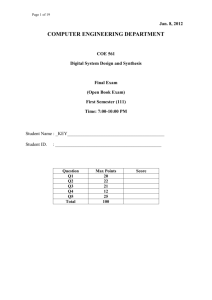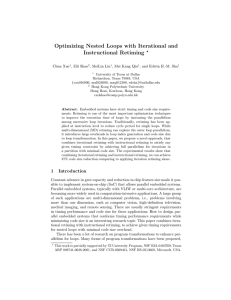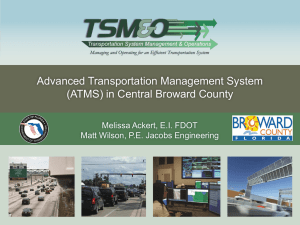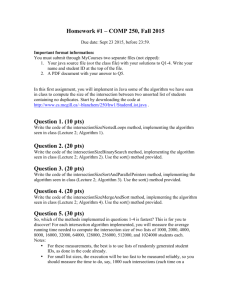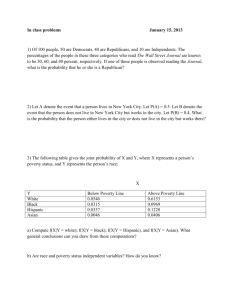The Benefits of Retiming Traffic Signals
advertisement
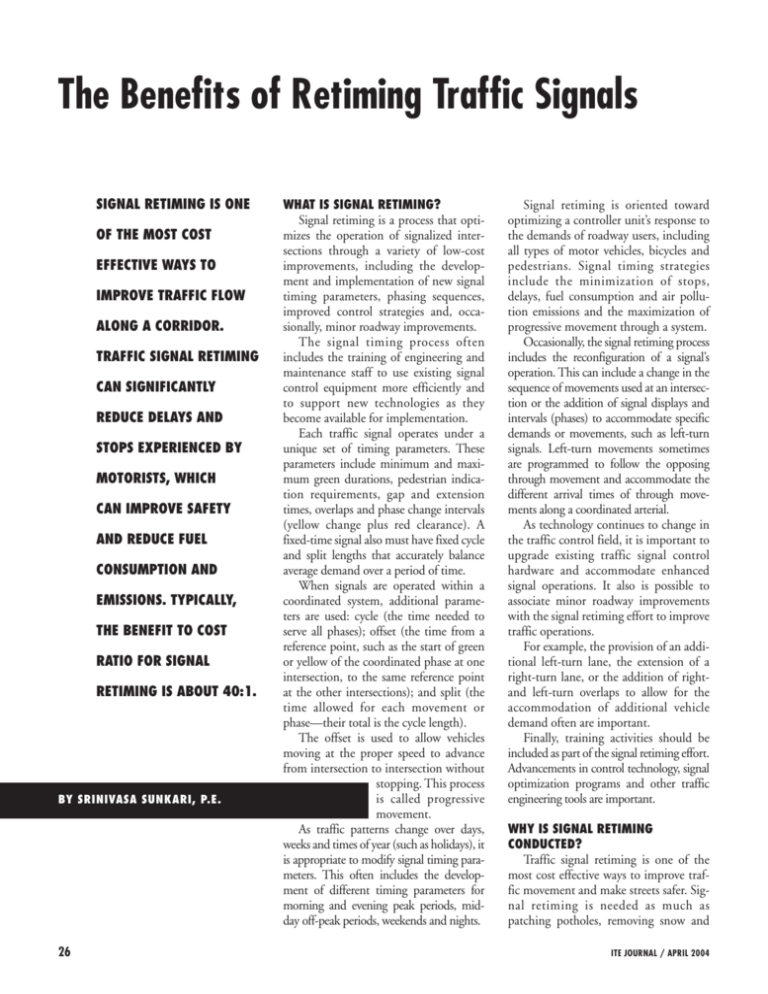
The Benefits of Retiming Traffic Signals SIGNAL RETIMING IS ONE OF THE MOST COST EFFECTIVE WAYS TO IMPROVE TRAFFIC FLOW ALONG A CORRIDOR. TRAFFIC SIGNAL RETIMING CAN SIGNIFICANTLY REDUCE DELAYS AND STOPS EXPERIENCED BY MOTORISTS, WHICH CAN IMPROVE SAFETY AND REDUCE FUEL CONSUMPTION AND EMISSIONS. TYPICALLY, THE BENEFIT TO COST RATIO FOR SIGNAL RETIMING IS ABOUT 40:1. BY SRINIVASA SUNKARI, P.E. 26 WHAT IS SIGNAL RETIMING? Signal retiming is a process that optimizes the operation of signalized intersections through a variety of low-cost improvements, including the development and implementation of new signal timing parameters, phasing sequences, improved control strategies and, occasionally, minor roadway improvements. The signal timing process often includes the training of engineering and maintenance staff to use existing signal control equipment more efficiently and to support new technologies as they become available for implementation. Each traffic signal operates under a unique set of timing parameters. These parameters include minimum and maximum green durations, pedestrian indication requirements, gap and extension times, overlaps and phase change intervals (yellow change plus red clearance). A fixed-time signal also must have fixed cycle and split lengths that accurately balance average demand over a period of time. When signals are operated within a coordinated system, additional parameters are used: cycle (the time needed to serve all phases); offset (the time from a reference point, such as the start of green or yellow of the coordinated phase at one intersection, to the same reference point at the other intersections); and split (the time allowed for each movement or phase—their total is the cycle length). The offset is used to allow vehicles moving at the proper speed to advance from intersection to intersection without stopping. This process is called progressive movement. As traffic patterns change over days, weeks and times of year (such as holidays), it is appropriate to modify signal timing parameters. This often includes the development of different timing parameters for morning and evening peak periods, midday off-peak periods, weekends and nights. Signal retiming is oriented toward optimizing a controller unit’s response to the demands of roadway users, including all types of motor vehicles, bicycles and pedestrians. Signal timing strategies include the minimization of stops, delays, fuel consumption and air pollution emissions and the maximization of progressive movement through a system. Occasionally, the signal retiming process includes the reconfiguration of a signal’s operation. This can include a change in the sequence of movements used at an intersection or the addition of signal displays and intervals (phases) to accommodate specific demands or movements, such as left-turn signals. Left-turn movements sometimes are programmed to follow the opposing through movement and accommodate the different arrival times of through movements along a coordinated arterial. As technology continues to change in the traffic control field, it is important to upgrade existing traffic signal control hardware and accommodate enhanced signal operations. It also is possible to associate minor roadway improvements with the signal retiming effort to improve traffic operations. For example, the provision of an additional left-turn lane, the extension of a right-turn lane, or the addition of rightand left-turn overlaps to allow for the accommodation of additional vehicle demand often are important. Finally, training activities should be included as part of the signal retiming effort. Advancements in control technology, signal optimization programs and other traffic engineering tools are important. WHY IS SIGNAL RETIMING CONDUCTED? Traffic signal retiming is one of the most cost effective ways to improve traffic movement and make streets safer. Signal retiming is needed as much as patching potholes, removing snow and ITE JOURNAL / APRIL 2004 restriping pavement lines and markings. Following is a summary of the various reasons signal retiming is conducted: • By coordinating or sequencing signals in relation to each other, platoons, queues, or groups of vehicles can travel through a series of signals with minimal or no stopping. • The delay time on the approach to an intersection can be reduced by balancing the green time to reduce delay at that intersection. • With developments such as the addition of new homes or stores, traffic increases and creates a need to adjust the timing of affected traffic signals. • The diversion of traffic off a freeway or interstate due to an incident (an accident or event) associated with a computerized signal system can be accommodated. • Motorist frustration caused by excessive delays or stops can be reduced by adjusting timing to reduce stops and delays and provide coordinated flow through groups of signals. • Emissions and fuel consumption can be reduced by optimizing signal timing and coordinating traffic flow. • Emergency vehicles, buses and commercial vehicles can save time. • The number of severe collisions on city streets can be reduced by producing smoother traffic flow and fewer stops. • The need for costly reconstruction can be postponed or eliminated by providing improved flow using existing resources in a more cost efficient manner. • Changes in traffic flow for different times of day or days of the week can be accommodated. • Signal retiming should be conducted during a reconstruction project when a lane closure or traffic detour causes a significant change in demand or capacity. • Signal retiming is a cost effective method to improve traffic operation. It can produce benefit to cost ratios as high as 40:1. HOW IS SIGNAL RETIMING CONDUCTED? Signal retiming determines the timing to be entered in a controller using a series ITE JOURNAL / APRIL 2004 of calculations performed by a traffic engineer. The method for conducting signal retiming can be summarized as follows: • An inventory of the system is conducted to determine geometric conditions and other pertinent information and to gather field observations of current traffic conditions during peak traffic periods. • Traffic and pedestrian volume data are collected. Traffic counts include all turning and through movements as well as a classification of vehicles and the number of pedestrians using each crosswalk for each 15-minute interval of the study period. Travel time data also are collected for travel from one end of the system to the other, to identify current operating conditions. • A collision history and analysis are prepared. Collision records for the past three years are obtained. An analysis is conducted by preparing a collision diagram and causation, collision types and remedy tables to determine if a change in signal operation is likely to provide safer operation. • Collected data are processed and analyzed using capacity analysis, traffic signal timing optimization and simulation software programs. The model is calibrated using existing timing and the variables are adjusted to determine optimum signal timing. • Improved coordination offsets through a series or group of signals are determined using signal coordination software programs such as SYNCHRO or PASSER II. The results also may be tested using simulation software programs such as CORSIM. • The new timing is implemented at the intersection(s). • The new timing is evaluated in the field during various critical time periods and final adjustments are made. Travel time and delay studies are conducted when the final timing plans are in place. Before-and-after studies are conducted through the groups of signals to determine and document the improvement in traffic flow. • The process is repeated every three to five years, or more frequently based on changing conditions, to assure the continued optimum flow of traffic. WHO RETIMES TRAFFIC SIGNALS? Typically, the ultimate responsibility for signal retiming falls to the agency responsible for the operation of the roadways where signals are located. On state highways, state departments of transportation (DOT) usually have responsibility for the timing and operation of signal equipment and are tasked with the goal of providing optimal traffic flow. In their timing efforts, the state highway systems usually have priority. Local counties and municipalities that have responsibility for the operation of signals within their jurisdictions also may time traffic signals. Usually, this is performed within an agency’s public works or traffic engineering department, depending on the depth of staff available within the agency. In today’s environment of limited public resources and reduced staffing, many agencies are using the services of consulting engineers to perform signal timing projects. This is particularly applicable to periodic timing applications funded by grants or special funding opportunities. Political bodies, planning organizations and other advisory committees help drive the signal timing process indirectly by authorizing funding for signal timing studies and related improvements. In addition, the public is involved as a user and as an affected party. Signal timing complaints and requests often are received from the motoring public with requests to update studies or make signal timing improvements. WHAT ARE THE CONSTRAINTS OF OPTIMIZING AND OPERATING TRAFFIC SIGNALS? Many factors limit the extent to which intersection efficiency can be improved with the optimization of signal timing. Although they are interrelated, these factors, or constraints, can be broken into three general categories: institutional, physical and temporal. Institutional constraints on signal timing optimization pertain to the allocation of resources within an organization or agency and the relationship agencies have across jurisdictional boundaries. Competing budgetary demands within an agency may mean that insufficient resources (in terms of staff time and/or outsourcing 27 contracts) are available to perform the data collection, analysis and implementation necessary for proper signal operation, timing and maintenance. In arterial environments where multiple agencies are involved, a lack of cooperative working arrangements may produce inconsistent operation. Separate agencies also may place different priorities on signal control or may face equipment incompatibilities that limit the extent to which signal interconnection can be accomplished. Across and within agencies, a local political climate may exist that does not favor optimal signal and arterial operation. For example, an agency may be willing to accept non-optimal signal operation to increase real and/or perceived safety along an arterial corridor. Physical constraints are geometric barriers to more efficient signal operation. The more obvious examples of physical barriers include turn pockets of insufficient length, a lack of necessary turn pockets, or too few primary lanes for servicing traffic demand (lack of capacity). In such cases, green time allocation at a signal may be used to attempt to compensate for the limiting geometric feature(s). Irregular and/or close signal spacing also have a detrimental effect on signal efficiency, in that poor spacing places artificial restrictions on the amount of green time available for a platoon of vehicles to move from one intersection to the next without stopping. Also, mid-block access points may contribute enough traffic to the arterial to interfere with progression between intersections. Temporal (time) constraints are related to a signal’s inability to consistently provide adequate green time for traffic demand, given competing simultaneous demands from vehicles and pedestrians. This situation occurs when there is too much traffic for an intersection to physically process, when demand patterns vary to the extent that signal equipment cannot be programmed realistically to accommodate the broad range of hourly/daily/weekly/monthly traffic fluctuations, or when too many conflicting movements require excessive green time (for example, heavy left-turn movements and through movements from multiple approaches at one intersection). 28 Time constraints also can be imposed by pedestrian signal demands that, with relatively long clearance intervals, may be more demanding of intersection green time than vehicular approaches to an intersection. In addition, the increasing use of emergency vehicle and transit priority and the high-level demand of railroad preemption may mean that green time must be diverted for priority and safety reasons, regardless of capacity conditions at an intersection. Vehicles leaving factories, schools, or other large traffic generators at the same time also can impact traffic severely at a nearby intersection. HOW OFTEN SHOULD SIGNAL RETIMING BE CONDUCTED? Signal timing is effective only as long as the traffic patterns that were used to generate the signal timing are reasonably constant. Traffic patterns change over time; developments in surrounding areas also can cause a significant change in traffic patterns. Existing signal timing cannot operate efficiently with newer traffic patterns. Signal timing should be fine-tuned to operate better. For traffic signals to operate efficiently, the complete retiming of a traffic signal or system often is necessary. Traffic engineers should review traffic signal and system performance continuously. Ideally, signal timing should be reviewed every year to evaluate effectiveness and efficiency. If necessary, a thorough signal retiming should be conducted. At a minimum, an operating agency should budget to retime traffic signals at least every three years, especially in developing areas and/or areas with sustained growth. WHAT IS THE COST OF RETIMING TRAFFIC SIGNALS? Signal retiming often is postponed or ignored due to an agency’s financial or staffing constraints. Given the need for field data collection, data analysis, signal timing optimization, testing and implementation, the overall signal timing process can be expensive and time consuming. However, as discussed earlier, retiming traffic signals is necessary to maintain efficient traffic operations. Estimates of the time required vary according to available expertise and equipment. On average, it is estimated that gen- erating four timing plans (for a.m. peak, noon peak, p.m. peak and off-peak conditions) takes 25 to 30 hours per intersection. The cost of signal retiming is roughly $2,500 per intersection, including the four typical timing plans. However, a recent signal retiming study in the Washington, DC, USA, area was completed at an average cost of $3,500 per intersection. WHAT ARE THE BENEFITS OF RETIMING TRAFFIC SIGNALS? Signal retiming has significant benefits for the traveling public. One of the direct benefits is the reduced delay experienced by motorists. Delay savings are more apparent for motorists traveling along coordinated signalized arterials. Motorists experience fewer stops and reduced fuel consumption. Apart from the direct benefits, there also is a general public perception of reduced delay during travel. A side benefit may be reduced motorist frustration and improved safety. Improving signal timing also has other indirect benefits. Reduced fuel consumption reduces emissions and, hence, improves air quality. Efficient signal timing also minimizes diversion of traffic to local and residential neighborhoods, potentially improving safety and traffic conditions in those areas. Improved traffic flow also reduces pavement wear and tear, minimizing the maintenance requirements of the public works department. Finally, signal retiming efforts are opportunities for operating agencies to conduct quality control checks on controller settings for pedestrian, preemption and priority requirements. Figure 1 gives a good illustration of the savings in user costs if traffic signals are retimed. The figure demonstrates that retiming traffic signals at periodic intervals provides significant savings in user costs in the form of reduced delays, stops, fuel consumption and other measures of effectiveness. EXAMPLES OF SUCCESSFUL RETIMING PROJECTS • Since summer 2002, the Maryland DOT has retimed about 215 signals in the Washington, DC, USA, suburbs and an additional 30 signals on ITE JOURNAL / APRIL 2004 tion arterial reduced average arterial delay by 94 percent and arterial stops by 77 percent, resulting in estimated annual fuel savings of 3,300 gallons and overall annual cost savings of $93,000 (2001). • On San Jose Boulevard in Jacksonville, FL, retiming traffic signals at a 25-intersection section reduced average arterial delay by 35 percent, arterial stops by 39 percent and arterial travel time by 7 percent, resulting in estimated annual fuel savings of 65,000 gallons and overall annual cost savings of $2.5 million (2001). If retimed only once at the end of 3 years Savings at the end of 6 years — Area A Savings at the end of 9 years — Area A + B User costs If retimed at the end of 3 and 6 years Savings at the end of 9 years — Area A + B + C B C A 1 2 3 4 5 6 7 8 9 10 Years Figure 1. Savings in user costs due to signal retiming. the Route 650 (New Hampshire Avenue) corridor between Montgomery County, MD, USA and the District of Columbia. An analysis has shown that delays on these roads shrunk by about 13 percent and vehicles made 10 percent fewer stops at red lights. Fuel consumption also dropped by about 2 percent. • Adjusting signal timing in Lexington, KY, USA, by responding to real-time traffic data reduced stopand-go traffic delays by about 40 percent and accidents by 31 percent. • According to the Institute of Transportation Engineers (ITE), traffic signal improvements reduce travel time by 8 to 25 percent. The reduction in travel time also reduces fuel consumption and emissions. • The Fuel Efficient Traffic Signal Management Program in California demonstrated a benefit to cost ratio of 58:1. The program retimed 3,172 signals, resulting in 15-percent savings in delays, 8.6-percent savings in fuel consumption, 16-percent savings in stops and 7.2-percent savings in travel time (1988). • The Traffic Light Synchronization (TLS) Program in Texas showed a benefit to cost ratio of 62:1. By retiming traffic signals with the TLS program, Abilene, TX, experienced reductions of 14 percent in travel time and 37 perITE JOURNAL / APRIL 2004 cent in delays. Overall, the program resulted in a 24.6-percent reduction in delays, a 9.1-percent reduction in fuel consumption and a 14.2-percent reduction in stops (1992). • In Kitchener-Waterloo, Canada, 89 intersections that included arterials in commuter and commercial routes and central business district areas were retimed. The project demonstrated savings of 10 percent in travel time, 27 percent in delays and 20 percent in stops (1996). • In another project in Burlington, Canada, which contained 62 intersections, 7-percent savings in travel time, 11-percent savings in stops and 6-percent savings in fuel consumption were observed. The project demonstrated an annual savings of $1.06 million for delays and fuel consumption alone. Based on total savings, the payback period for this project was just 13 days (2001). • On U.S. 1 in St. Augustine, FL, USA, retiming traffic signals at a 11intersection arterial reduced average arterial delay by 36 percent, arterial stops by 49 percent and arterial travel time by 10 percent, resulting in estimated annual fuel savings of 26,000 gallons and overall annual cost savings of $1.1 million (2001). • On RS 26 in Gainesville, FL, retiming traffic signals at an eight-intersec- ACKNOWLEDGMENTS This feature is an interim product of the ITE Traffic Engineering Council’s project TENC-101-02. The following Traffic Engineering Council members contributed to this feature: John Abraham, City of Troy, MI, USA; Don Bennett, City of Wilmington, NC, USA; Bryan Haigh, Read, Voorhees & Associates Limited, Toronto, Canada; James Harris, City of Rancho Cucamonga, CA, USA; Jim Poston, Meyer Mohaddes Associates Inc., Reno, NV, USA; Carol Jones, South Carolina Department of Transportation, Columbia, SC, USA; Bill Kloos, City of Portland, OR, USA; Susan Langdon, Siemens ITS, Plano, TX, USA; Steven Venglar, Texas Transportation Institute, San Antonio, TX; Paul Vetter, Edwards and Kelcey, Jacksonville, FL, USA; and Pete Yauch, TEI Engineers & Planners, Tampa, FL. ■ SRINIVASA SUNKARI, P.E., is an associate research engineer at the Texas Transportation Institute in College Station, TX, USA, where he conducts research in traffic operations and intelligent transportation systems applications. He has served on the Brazos Valley TexITE chapter board and currently is chair of the ITE Committee on Benefits of Signal Retiming for the Traffic Engineering Council. He holds a bachelor’s degree from Osmania University in India and a master’s degree from Texas A&M University. He is a member of ITE. 29
